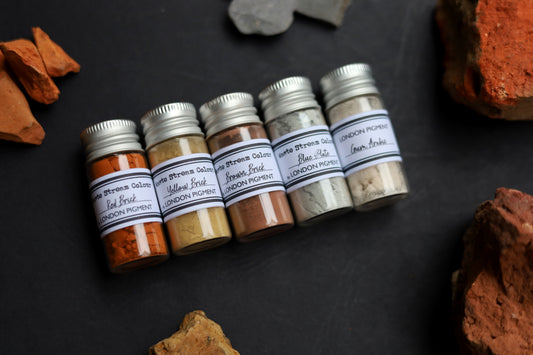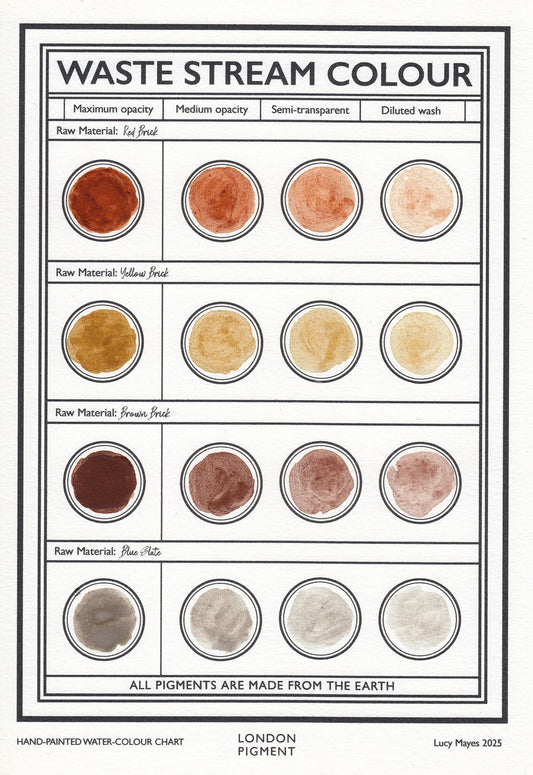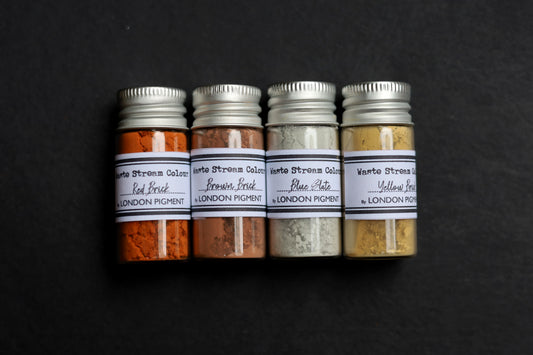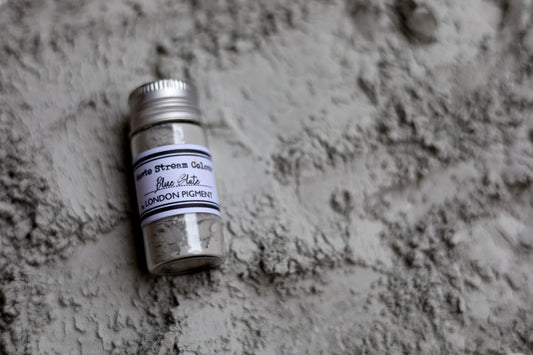Burnt Earths
Case Study: Burnt London Earths for Pigments Revealed International
For Pigments Revealed International, a non profit organisation dedicated to sharing knowledge about pigments I was invited to help celebrate their ‘Pigment Of The Month for June 2022: Yellow Ochre’ by producing colour charts and an article relating to calcination in earth pigment practices. I wrote a short article about historical burning practices and recreated some palaeolithic pigments by heating London yellow ochres to 600 celsius in my studio oven.
The following text appears on their website as an educational article available for general use.
Making Red Ochre Pigment from Yellow Ochre
By Lucy Mayes


Why use fire?
I am reluctant to mix different pigments to get to a particular shade or colour combination. The reluctance came about from the labour and time invested in cajoling a particular hue from its raw form into existence. Teasing and coaxing colour compounds from nature’s ingredients is a satisfying task. Why would I want to adulterate a pigment that, in a way, was the condensed essence of a plant, rock or other starting material? Painting is like playing a game with oneself and making pigment is like playing a game with nature, as one must either accept the impurities that come along with the raw materials or try to make a different move, or react; and distill, sieve, clean or purify a colour extraction. Abstracting coloured juices or decoctions from these materials brings about a deep relationship with them. It is said that there was a tendency to use single pigment paints, without mixing them in the European medieval manuscript tradition to keep the colours bright. This rationale was twofold: practically motivated, to stop painters from muddying their colours but also to appease superstitious anxieties surrounding the adulteration of them.
The fastidiousness needed to create a colour with chromatic purity, or an unadulterated shade from raw materials requires some grit. Pigment makers inadvertently depend on nature’s fluctuations, and my recipes are full of intuition rather than precise measurements. It seems paradoxical to spend all that time on creating this almost essence-like extraction to throw away its individual character by mixing it up with something else. With this thinking, one might expect me to be overly cautious and precious about my pigments, if it weren’t for my pyromaniacal leaning. I would describe myself as a sensitive soul, especially in regard to sensation. I have lived by the sea most of my life in East Sussex, where the white monumental chalk cliffs were my backdrop. I’m scared of flying, so that's air crossed off the list, and then we are left with fire. Pigments come into fruition through collaboration with the elements, fire, water and air. Rather than mixing and diluting a pigment to make a new colour, heat can be used instead. So it is fire that I choose as a pyrotechnology to alter the shade and even the hue of my earth colours.


Turning yellow to red
Yellow ochre and red ochre are the common pigment names for Goethite [α-FeO(OH)] and Hematite [Fe2O3]. These minerals both contain forms of iron oxide, are found naturally occurring but rarely pure, often present alongside silicate minerals like clays, quartz, and feldspars, calcium compounds, other metal oxides and carbonates etc.
Goethite is known as an ‘iron oxide hydroxide’, is a hydrated iron oxide, so contains water in its makeup. Hematite as an iron oxide, in its purest form contains 70% iron and 30% oxygen. Both compounds are formed as common weathering products of iron-bearing minerals like magnetite and pyrite. Hematite is the primary source of iron metal for the steel industry. Limonite was the general name given to weathering by products mentioned above, before modern mineral analysis and is still used today to describe yellow or brownish iron oxides.
We can create red ochre synthetically, as on heating, Goethite can be burnt, or calcined into Hematite. This change is due to the dehydration of the material, and through a loss of water content the mass and structure of the particles change too. Goethite dehydrates at temperatures in the range 250°C up to approx 700°C to form hematite. The longer the exposure to the heat and the higher the temperature, the darker the red produced.
In plane polarised light, yellow ochre appears to be composed mainly of rounded yellow particles, but some reddish or brownish ones are present in many samples. The size of the particles can range from 1-5 micrometers, and they can vary from isotropic to strongly birefringent. Once heated these particles change and become more crystalline in structure, with more acute angles. Haematite may include quite large transparent splintery particles. It can also appear as roughly circular particles with a radiating structure, or segments broken from them. The splintery appearance is coupled with sharp edges or pointed ends. Iron red pigments can be made by heating poor quality yellow ochre and these pigments retain the typical particle shapes and sizes of the ochre that has been used. It is not unusual for these pigments to look very different in their various forms; when found as minerals in nature, or ground into a fine powder they might look darker or more dull. It is in mixing with a binding medium that their colour is truly revealed. A test for their colour potential is this: when rubbed on a raw, or bisque fired ceramic surface hematite leaves a reddish brown streak colour while goethite leaves an ocher-yellow colour.
The colour change from yellow to red is a thermal transformation within the crystal lattice of the pigment particles. Particle size, shape and crystal structure can all affect the resultaning hue of the pigment. These qualities affect the handling of the paint, its transparency, and how fast it dries. To investigate these colour changes I experimented with local earth colours from my locality in London. I chose yellow ochres from North-East and West London to experiment with.

Experiments with London Ochres
I have been burning my London earth colours for a few years now to get darker, browner shades for my paintings, however I hadn’t tried to get a red from them. I always thought it would require a kiln to create deep shades of red ochre. But colour changes can start at just 300 celsius, depending on the constituent parts of your ochre. The gas ring I use can reach up to 650 celsius. I tried heating my pigments in a pan above the flame and also directly on the flame as I had some pigment press cakes. (pigment mixed with water and dried into small lumps).
The pigments I used were Epping yellow and Hampstead yellow, yellow ochres collected from around these areas in London. These pigments were extracted via a process of levigation (and usual earth pigment processing techniques such as washing and sieving) from London Clay. Compared with yellow earths from France for example they are muted and duller in tone due to there being more impurities from the local London Basin Geology.
The London Basin area is formed from a layer of chalk accumulated on the bed of a warm sea in the Cretaceous period over 65 million years ago. Together with much of Southern Britain, at the same time the Alps were being formed around 15-20 million years ago, the area was folded to form a shallow basin.
Within the London clay strata there is a mix of four main parts, the ratio of which contributes towards local clay hues leaning towards a certain colour bias. These parts are:
Smectite
A category of clay minerals that have a three-layer crystalline structure (one alumina and two silica layers) and that exhibit a common characteristic of hydrational swelling when exposed to with water
Silicate minerals
These are rock-forming minerals made up of silicate groups. They are the largest and most important class of minerals and make up approximately 90 percent of Earth's crust.
Kaolin/ kaolinite
Pure white clay used as a pigment, filler in many industries
Chlorite
Chlorite is a member of the mica group of minerals (sheet silicates), green in color, have a foliated appearance, perfect cleavage, and an oily or soapy feel. Gives London Clay its green tinge.



The presence of iron in London Earth
Iron rich earth found by river banks, beds and their sources can owe its presence there to acid rock drainage or (ARD). The pyrite that can be found throughout London Clay is a mineral containing iron that contributes towards areas of iron rich earth that can be used for pigments.
(ARD) is the outflow of acidic water from metal or coal mines, but can also refer to waters associated with areas of geology that have had the water table in the vicinity physically disturbed. It occurs naturally within some environments as part of the rock weathering process but is exacerbated by large-scale earth disturbances characteristic of mining and other large construction activities, usually within rocks containing an abundance of sulfide minerals.
After being exposed to air and water, oxidation of metal sulfides (pyrite), which is iron-sulfide within the surrounding rock and overburden generates acidity. Colonies of bacteria and archaea greatly accelerate the decomposition of metal ions, although the reactions also occur in an abiotic environment. These microbes are called extremophiles for their ability to survive in harsh conditions.


Before calcination
Epping Yellow and Hampsetad yellow are similar colours, however Epping Yellow is a softer yellow with less iron oxide and more impurities present within the London Clay.
Process
The pigments I heated in a pan on top of the gas ring changed very quickly.
2-5 minutes
Became a much more golden yellow
5-7 minutes
Become much browner
15+ minutes
Became a much darker brown almost black.
After heating
The pigment press cakes seemed to work much better in creating a reddier colour, as opposed to brown. The process of colour change was the same for the press cakes, however before turning brown there was a sweet spot where both yellow ochres had a richer, more reddier colour. One of the reasons for the pigment becoming dark brown and then black is perhaps the presence of organic material in the pigment that could have carbonized.
The longer I heated both of the London earth pigments, the larger the particle size. The particles also seemed denser and acted differently when mixed with a binding medium. I could not grind the particles any smaller in my pestle and mortar so I assume they are also harder too.
Some interesting temperature-induced chromatic alterations occurred
Due to the heating of the pigment, the refractive index of hematite is 2.91- 3.19, higher than that of Goethite, which is 2-2.4 respectively. But how does this affect how colour is perceived? We would need to be an expert in optical crystallography to find out. But if the pigment becomes more crystalline in structure, we can deduce that it refracts the light differently and therefore as the structure is different of each individual particle then light interacts with them differently too.



Sources:
https://geology.com/minerals/hematite.shtml
https://www.sciencedirect.com/topics/earth-and-planetary-sciences/limonite
https://aip.scitation.org/doi/pdf/10.1063/1.5038308
https://www.researchgate.net/publication/260314268_Chemical_and_mineral_transformation_of_a_low_grade_goethite_ore_by_dehydroxylation_reduction_roasting_and_magnetic_separation
https://academicprojects.co.uk/yellow-pigments/
https://academicprojects.co.uk/red-pigments/
https://www.sciencedirect.com/science/article/pii/B9780081029084001624
https://www.sciencedirect.com/sdfe/pdf/download/eid/3-s2.0-B0123485304001946/first-page-pdf
https://horizon.documentation.ird.fr/exl-doc/pleins_textes/pleins_textes_5/b_fdi_18-19/25071.pdf
https://geology.com/minerals/limonite.shtml
https://blogs.ucl.ac.uk/pigment-timeline/2020/04/01/the-origin-of-ochres-interbasaltic-beds/
https://www.mdpi.com/2075-163X/11/1/67/htm
Waste Stream Colour Products
-
Waste Stream Watercolour Complete Set
Regular price From £70.00 GBPRegular priceUnit price per -
Waste Stream Colour Chart
Regular price £15.00 GBPRegular priceUnit price per -
Waste Stream Colour Full Set
Regular price From £60.00 GBPRegular priceUnit price per -
Blue Slate Pigment
Regular price £15.00 GBPRegular priceUnit price per



